
‘12
Getting Back in the Saddle

Sola rides Umber.
On Bainbridge, the height of August is the height of summer. These halcyon days pass in a golden glow, with blackberry-stained chins and meteor showers in the cloudless starry nights. Last week, for the first time since late in her pregnancy, Sola and I both found time to play with the equines together.
I strapped Aine into a baby backpack and practiced easy lessons with Murry, the older of our two mules. Meanwhile, Sola rode Umber in a series of equestrian dances — high-stepping trots and fluid canters, outpacing the lazy calm of the radiant afternoon. What a treat it was for us both to play with our mule friends!
‘12
The Ones That Got Away

A Silver-Spangled Hamburg hen perches on a telephone line.
In early July, I wrote about the eagle that had been preying on our chickens. The eagle still makes the rounds — sometimes with three of its kin — but we haven't seen it catch any chickens since June 28th.
Occasionally, though, we have a good scare. Chickens can be prone to drama and histrionics even without predators present, which means that we've often come running to a commotion that turned out to be a pair of hens squabbling. One day in mid-July, we'd seen the eagle circling and suddenly heard a chicken screaming. Sola dashed to the scene, and saw something we dread.

Chicken feathers strewn across the lawn.
Chicken feathers in the lawn mean there's been a struggle, typically of the mortal variety. It looked like the eagle had claimed one of our Silver-Spangled Hamburgs. They've been fine hens: A bit standoffish, but bright-eyed, intelligent and good at fending for themselves. On the other hand, their black-and-white plumage makes them easy for predators to spot.
Counting feathered heads, Sola ascertained that we hadn't lost a chicken after all. All of our Hamburgs were accounted for, but one of them was somewhat worse for wear. The diving eagle had swooped in low for an attack but came out of the dive with talons full of feathers. The right side of her tail had been plucked clean of feathers.
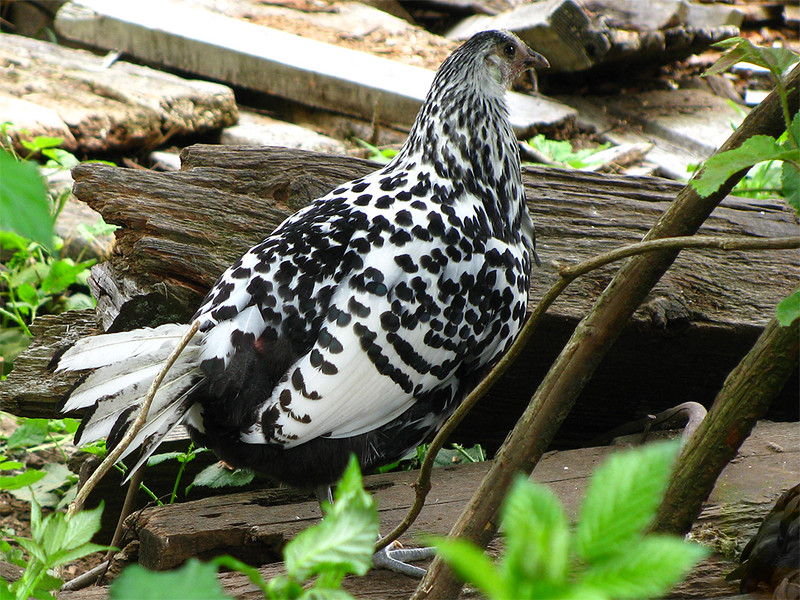
Silver-Spangled Hamburg missing the right half of her tail.
In spite of losing half her tail, she seemed perfectly able to continue foraging and has since grown the feathers back (though they're half the length they were previously).
Yesterday we had another close call. We heard an animal raising a ruckus, but were deep in the fields and not able to come running. Ten or twenty minutes later, we came up to the porch and saw the scene pictured in this entry's first photo: one of the Hamburg hens was perched about twenty feet up on the telephone wires.
We were a bit flummoxed — why would she find such a high perch? Eagles, of course, would not be slowed down in the least by high-perching prey. We didn't wonder for long. Our questions were answered by the appearance of a golden-brown coyote springing down our overgrown road. A terrifying encounter must have ended when our alert little chicken flapped an expeditious retreat.
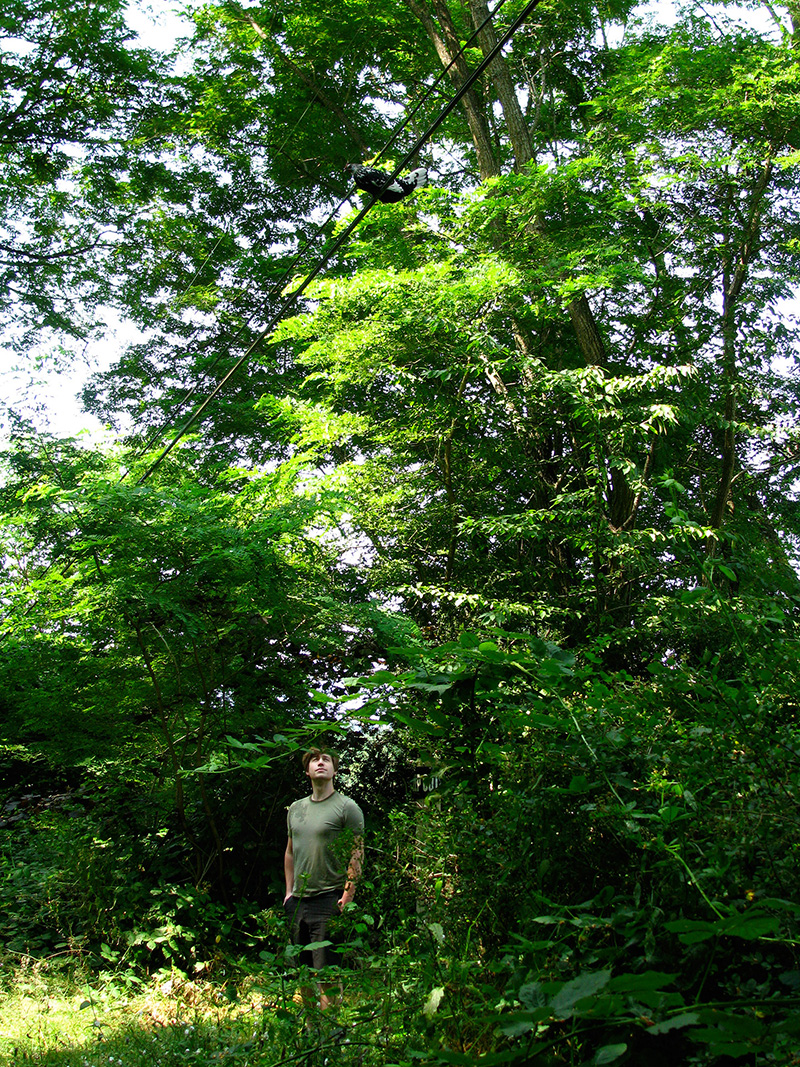
Felix looks up at a Silver Hamburg hen perched high above.
‘12
Good Eating
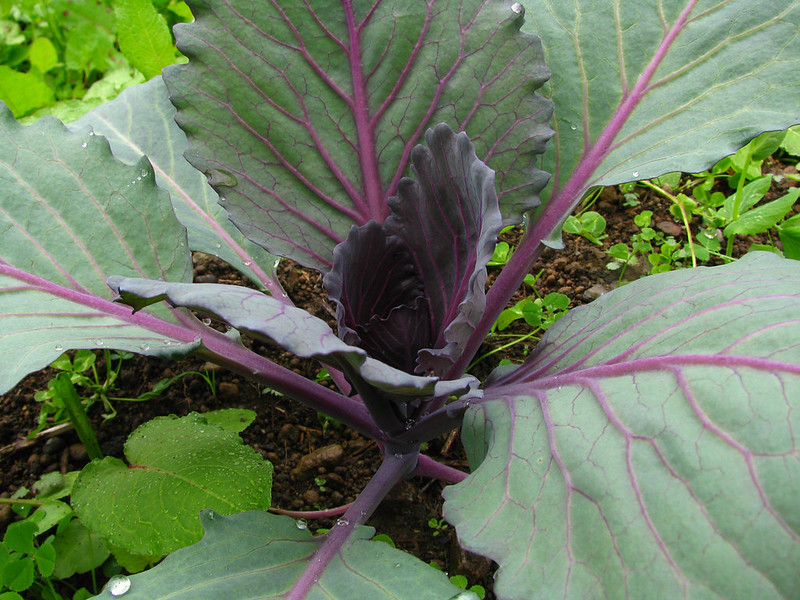
Red Cabbage, circa July 3rd
June and July came and went and I didn't write a word about our garden. Now it's August and we've been eating, weeding, and mulching our own vegetables for a couple months. It seems like just yesterday we were digging the garden rows. Where did the time go?
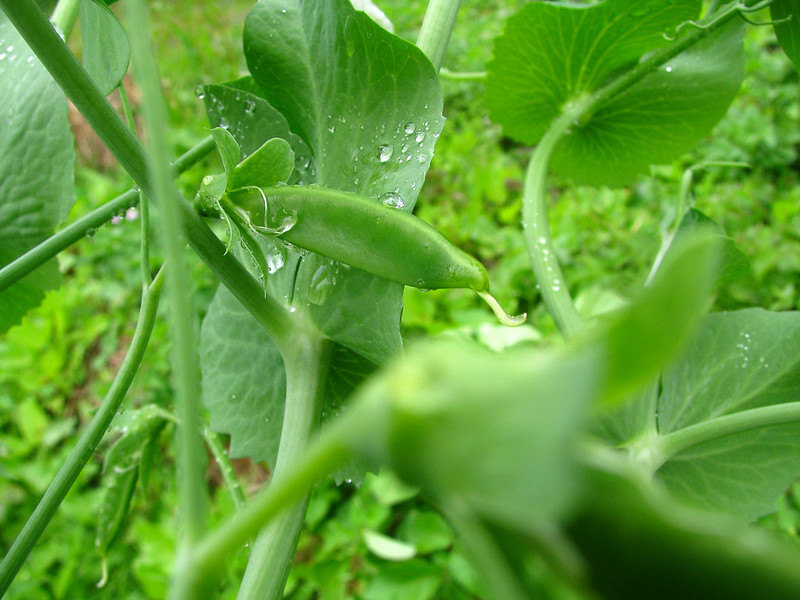
Snap peas after a summer rain.
Despite a healthy snap pea crop, very few have made it as far as the kitchen. Whoever gets out to the pea vines first gets a fistful (or two) of peas. We have two more generations of pea vines coming along to prolong our enjoyment of this favorite summer snack.
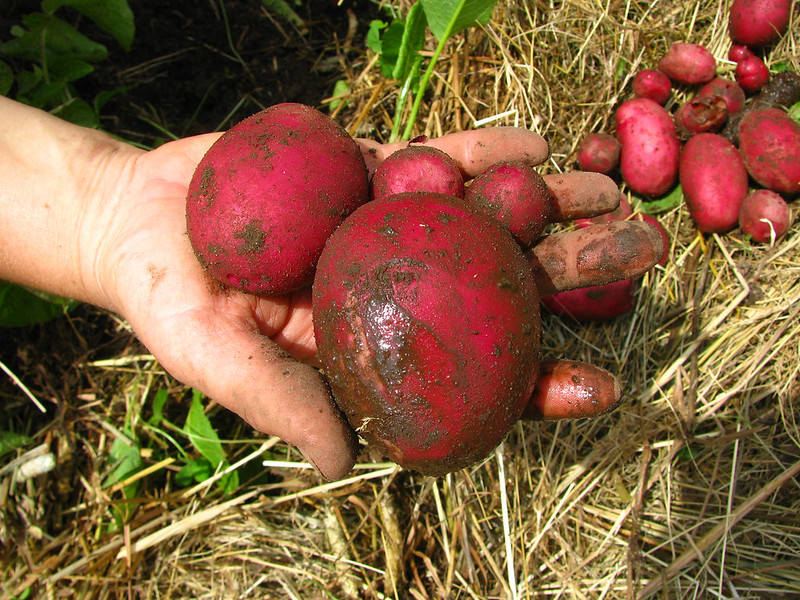
Red potatoes, fresh out of the ground.
Early in July, we dug up some of our potato plants because they looked as though they weren't thriving. The leaves looked a bit shriveled and their color wasn't quite as good as the others. Underneath each plant, however, were several potatoes. It seems that the plants were producing just fine, even if they weren't quite as picturesque as we'd hoped. After harvesting the tubers, we planted them back in the ground in hopes that they'll produce a few more potatoes before the year is out.

Freshly chopped red potatoes.
Once we'd scrubbed the dirt from our potatoes, we found them to be an incredibly vivid hue of red! Even the finest potatoes we've found in the supermarket and farmer's markets seemed washed out — as though waiting even a day to eat them was long enough for the color to fade. As an added bonus, they were wonderfully flavorful.
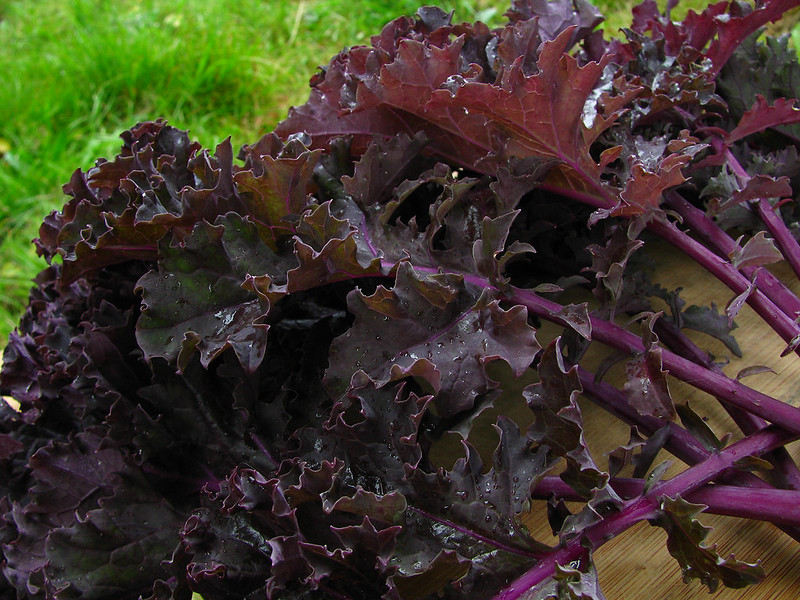
Purple kale arrayed on a cutting board.
One ongoing treat has been the assortment of leafy greens from the garden. The celery are happy as can be, the yellow chard has provided several meals, and we've gradually harvested stalks of purple kale to add color to the summer evening meals. The next generation of greens are seeded and sprouting; we should have lettuce and cilantro well into autumn.
‘12
Swarming Bees
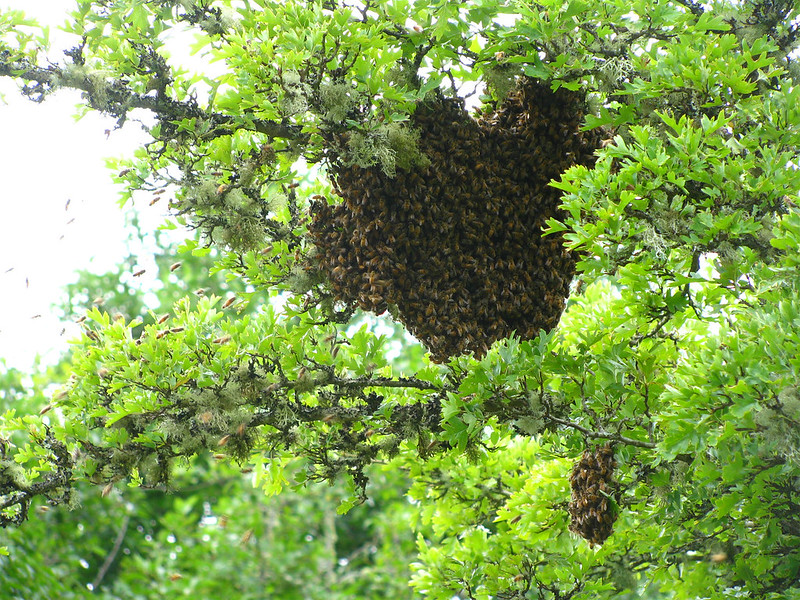
A swarm of bees gathers around their queen near the top of the hawthorn tree.
Wednesday promised to be nothing special. I was tired and sluggish. It was too hot. Motivation and comfort taunted me, just out of reach. A shout came from beyond the orchard, rousing me from midday's lackluster reveries. Sprinting from my desk, I didn't pause to doff my slippers at the door. I dodged cats and chickens, making haste to an ever-louder buzzing.

A swarm of bees fills the sky near the hawthorn.
The scene was nigh apocalyptic. Bees filled the air, swirling, swooping, and humming with a sound like vast machinery. Over the course of a half hour, they made a gradual migration to the top of the hawthorn tree. During that same period, we took a few deep breaths, deciphered the situation, and took action.
The story behind the bees' sudden swarming, we decided, was that they'd run out of room. The sultry weather of the past few weeks had resulted in a population explosion, and they didn't have the space they needed for a larger colony. A new queen hatched, and the old queen left with most of her workers — all fully laden and ready to build honeycomb for a new hive. These refugees had followed the queen to a branch of the hawthorn tree and were engaged in reconnaissance for a more permanent new home.
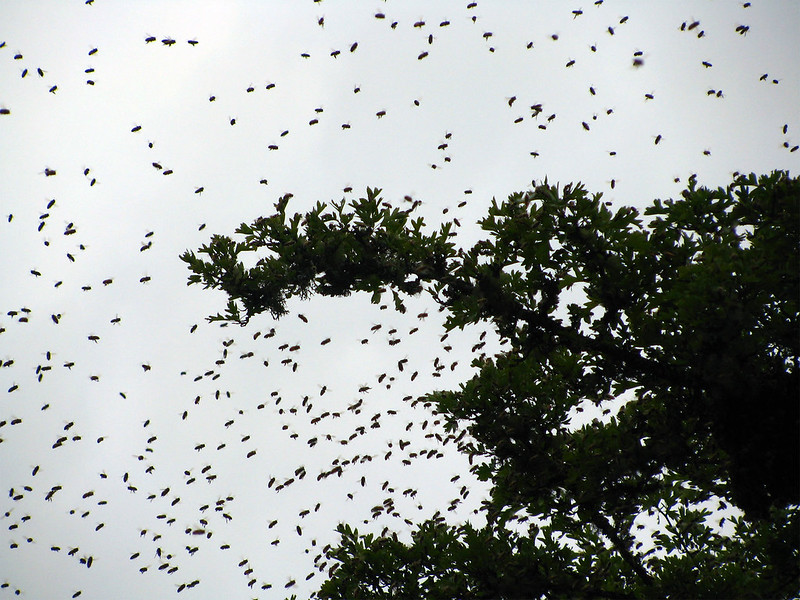
A closer look at the swarming bees.
Maia, Sola and Pat headed to Stedman's Bee Supplies for a new hive structure to put the bees in. Meanwhile, Erik and I gathered a few materials from around the farm to employ in our bee-catching. With a pole-saw, I cut out the branches directly below the bees' 20-foot-high cluster. We mounted a bucket to the end of a pole to catch falling bees. Lastly, I discovered a pipe suitable for hitting the branch the bees were clinging to — an old piece of plumbing about 22 feet long that had been laying in a pile of lumber.
After the tree had been trimmed and the hive boxes set up near the tree, we got to work. Maia and Erik donned their bee suits and Erik climbed up the ladder with the pole-mounted bucket. When he'd maneuvered the bucket into position under the bees, I repeatedly hit the branch with my pipe. When this proved insufficient to dislodge very many bees, he banged on the branch with the top of his bucket.
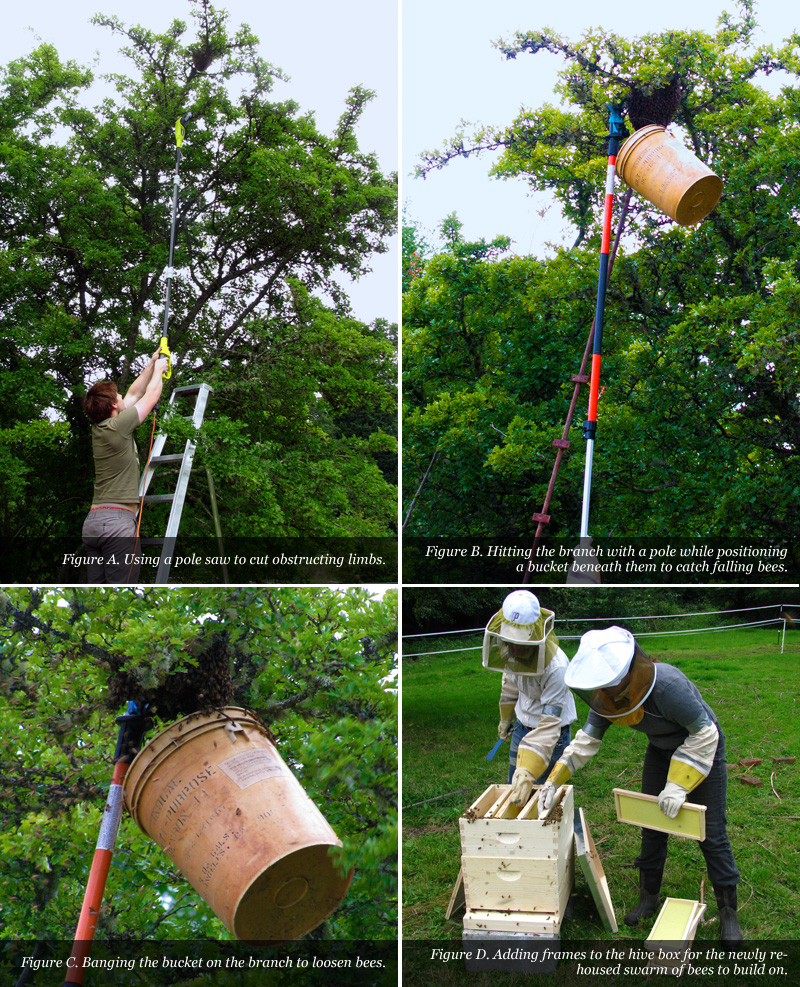
Not pictured: Pouring buckets of bees into the hive box.
We repeated this process three times, with Maia carrying the bucket full of bees to the hive and pouring them in after each attempt. On the third attempt, we knew we had the queen because the bees began flying towards the hive rather than away from it. Workers stood at the entrance and fanned the queen's scent out into the air as a beacon for lost bees. To make absolutely certain there was no lingering confusion, we cut the now-empty branch from the tree and placed it next to the hive.
Now it was time to finish up. Maia and Erik added frames to the inside of the hive box for the bees to build honeycomb on. Inspecting or adding frames requires a deep, meditative calm at the best of times. On this occasion, evening was falling and vicious biting midges arrived to test their serenity. They held it together and managed to avoid swatting any of the insects until after the job was done. After half a day of hectic activity, we had a fourth bee hive!

